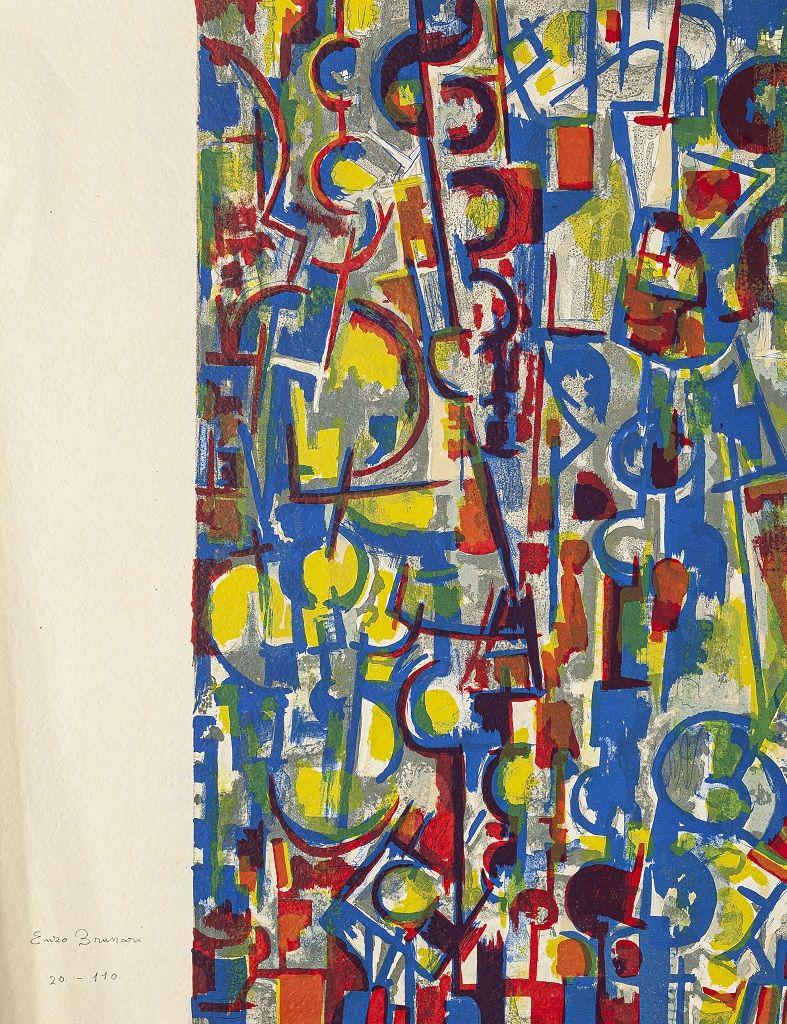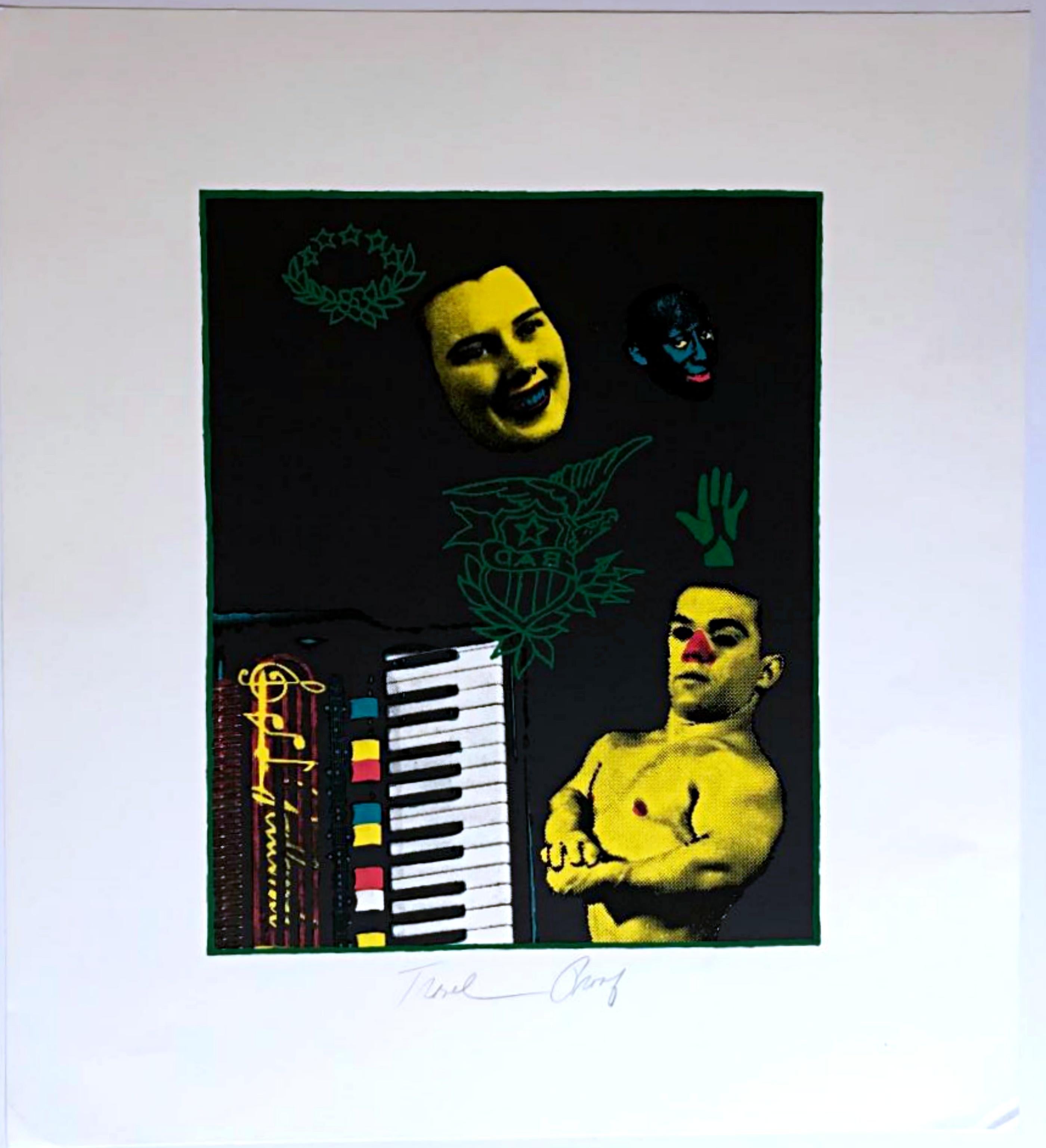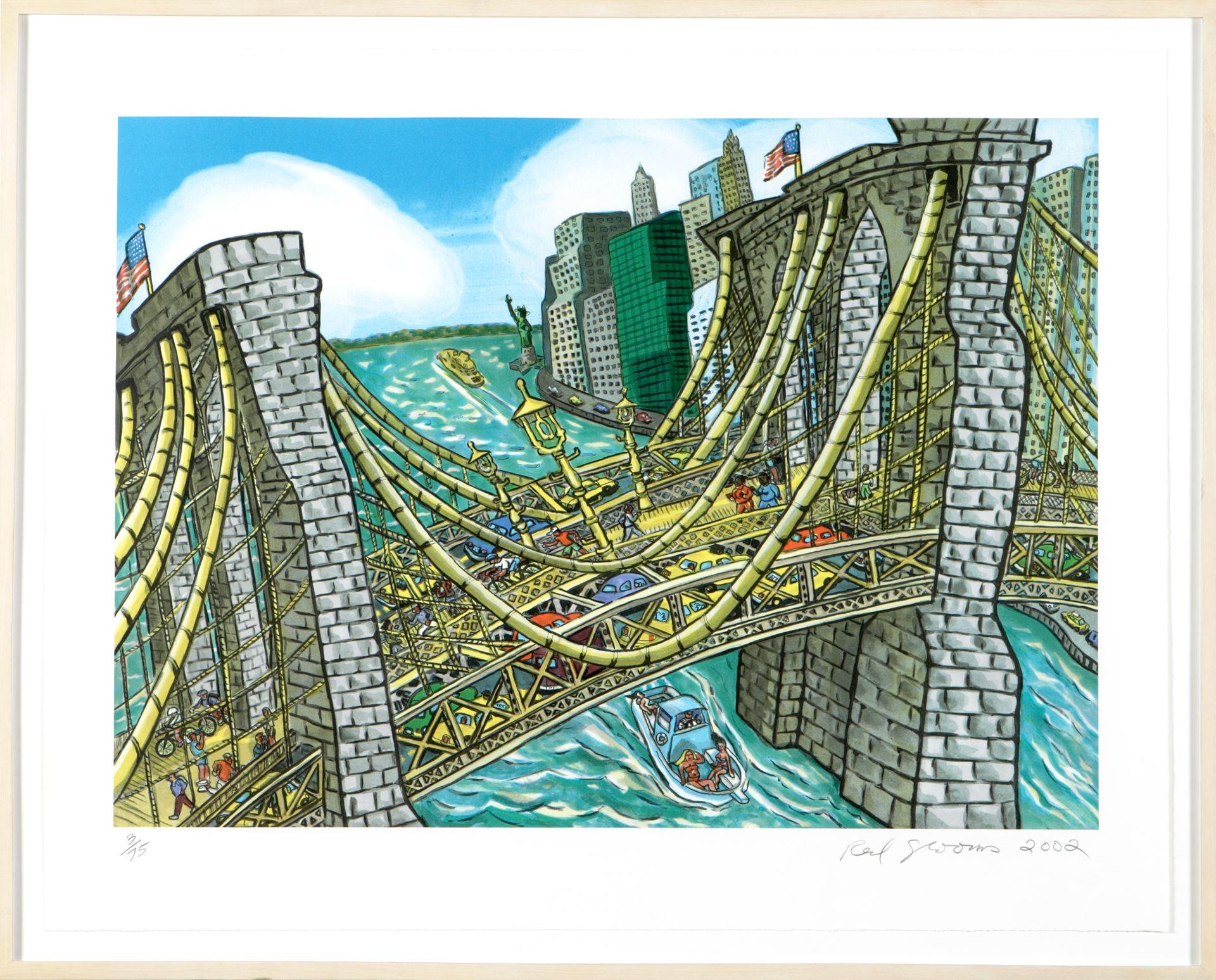Items Similar to Blankless Tone
Want more images or videos?
Request additional images or videos from the seller
1 of 10
Shusaku ArakawaBlankless Tone1979
1979
About the Item
Shusaku Arakawa
Blankless Tone, 1979
Color lithograph and silkscreen with embossing on Arches paper with deckled edges and folded collage upper left
Hand-signed by artist, Titled "Blankless Tone", signed "Arakawa", inscribed "1979 at New York City", and numbered 26/35, with publishers' blind stamp.
29 × 48 inches
Unframed
Dramatic light gold horizontal mixed media graphic work, pencil signed. numbered and inscribed, with text lettering and corner collage element. The Estate of Shusaku Arakawa is represented by Gagosian Gallery. This work is classic Arakawa - an important example of his way of displacing sometimes cryptic words onto images as a form of artistic philosophy and performance.
Shusaku Arakawa (荒川 修作 Arakawa Shūsaku, July 6, 1936 – May 18, 2010) who spoke of himself as an “eternal outsider” and “abstractionist of the distant future,” first studied mathematics and medicine at the University of Tokyo, and art at the Musashino Art University. He was a member of Tokyo’s Neo-Dadaism Organizers, a precursor to The Neo-Dada movement. Arakawa’s early works were first displayed in the infamous Yomiuri Independent Exhibition, a watershed event for postwar Japanese avant-garde art. Arakawa arrived in New York in 1961 with fourteen dollars in his pocket and a telephone number for Marcel Duchamp, whom he phoned from the airport and over time formed a close friendship. He started using diagrams within his paintings as philosophical propositions. Jean-Francois Lyotard has said of Arakawa’s work that it “makes us think through the eyes,” and Hans-Georg Gadamer has described it as transforming “the usual constancies of orientation into a strange, enticing game—a game of continually thinking out.” Quoting Paul Celan, Gadamer also wrote of the work: "There are songs to sing beyond the human." Arthur Danto has found Arakawa to be “the most philosophical of contemporary artists." For his part, Arakawa has declared: “Painting is only an exercise, never more than that.” Arakawa and Madeline Gins are co-founders of the Reversible Destiny Foundation, an organization dedicated to the use of architecture to extend the human lifespan. They have co-authored books, including Reversible Destiny, which is the catalogue of their Guggenheim exhibition, Architectural Body (University of Alabama Press, 2002) and Making Dying Illegal (New York: Roof Books, 2006).
Shusaku Arakawa was seven years old when the onset of World War II led his family to place him in a Buddhist monastery for two years to protect him. The conditions he endured there produced persistent nightmares, however, in the hope that his fears could be alleviated, he was sent to live with a neighborhood doctor and his wife for three years after the war. Arakawa became interested in medicine as a teenager and worked as the doctor's assistant while studying drawing, painting, and science in high school.
From 1954 to 1958 Arakawa studied medicine, mathematics and art in Japan and staged several "happenings". In 1960 he was affiliated with a Neo-Dada group in Tokyo and also participated in a demonstration against the continued existence of American military bases in Japan. To escape the controversy in which he then found himself embroiled, Arakawa moved to New York in 1961, where he met John Cage, Marcel Duchamp, and writer/philosopher Madeline Gins, whom he married.
Arakawa and Gins began to collaborate on a prodigious project called The Mechanism of Meaning, which melds physics, metaphysics, phenomenology and epistomology into a visual art form. A part of this series, approximately one-hundred panels, featuring images, texts, and objects, was first shown at the Venice Biennale in 1970. By this time Arakawa was also involved in filmmaking. He wrote and directed Why Not: A Serenade of Eschatological Ecology (1969), and collaborated with Gins on For Example (1971). Both films were shown at the Whitney Museum of American Art, New York.
Titled "Blankless Tone", signed "Arakawa", inscribed "1979 at New York City", and numbered 26/35, with publishers' blind stamp.
Excellent condition; the fold on the upper left is part of the collage design. The work was framed so there is some tape residue on the back
- Creator:Shusaku Arakawa (1936 - 2010, Japanese)
- Creation Year:1979
- Dimensions:Height: 29 in (73.66 cm)Width: 48 in (121.92 cm)
- Medium:
- Movement & Style:
- Period:
- Condition:Excellent condition; the fold on the upper left is part of the collage design. The work was framed so there is some tape residue on the back.
- Gallery Location:New York, NY
- Reference Number:1stDibs: LU1745212605512
About the Seller
5.0
Platinum Seller
These expertly vetted sellers are 1stDibs' most experienced sellers and are rated highest by our customers.
Established in 2007
1stDibs seller since 2022
299 sales on 1stDibs
Typical response time: 1 hour
- ShippingRetrieving quote...Ships From: New York, NY
- Return PolicyA return for this item may be initiated within 1 day of delivery.
More From This SellerView All
- BAD (silkscreen and lithograph print) by renowned Chicago artist expressiionistBy Ed PaschkeLocated in New York, NYEd Paschke BAD, 1991 Silkscreen and Lithograph on Rising Mirage Paper, accompanied by documentation Pencil signed, titled "BAD", and annotated "Trial Proof" on the front 22 × 20 inches Unframed This work is a unique Trial Proof on Rising Mirage Paper, pencil signed by the artist and annotated "Trial Proof" the very first impression, aside from the regular edition. It is accompanied by the tirage sheet, with the biography of the artist and a description of the work. (see photos). As such it is a rare impression. Published by Chicago Serigraphic Workshop and Artco, Incorporated Ed Paschke Biography: Ed Paschke was born in Chicago where he spent most of his life as an important painter. He was initially associated in the late 1960s with the second generation of Chicago Imagists who called themselves The Hairy Who. He received his B.F.A. from the School of The Art Institute of Chicago in 1961 and his M.F.A. in 1970. Between degrees he lived for a time in New York where he easily came under the influence of Pop art, in part, because of his interests as a child in animation and cartoons. His fascination with the print media of popular culture led to a portrait-based art of cultural icons. Paschke used the celebrity figure, real or imagined, as a vehicle for explorations of personal and public identity with social and political implications. Although his style is representational, with a loose affiliation to Photorealism, Paschke’s art plays...Category
1990s Contemporary Abstract Prints
MaterialsMixed Media, Felt Pen, Lithograph, Screen
- Cacophonous PACE Gallery exhibition catalogue (hand signed by Robert Irwin)By Robert IrwinLocated in New York, NYRobert Irwin Cacophonous (hand signed by Robert Irwin), 2015 Softback exhibition catalogue with stiff wraps (hand signed by Robert Irwin) Hand signed by Robert Irwin on the title pag...Category
2010s Contemporary More Art
MaterialsPaper, Ink, Mixed Media, Lithograph, Offset, Screen
- The Degrees of Meaning, from Realities and ParadoxesBy Shusaku ArakawaLocated in New York, NYShusaku Arakawa The Degrees of Meaning, from Realities and Paradoxes, 1973 Color Lithograph and Silkscreen Hand signed, numbered from the edition of only 100 and dated on the front (lower right hand corner). Bears the Styria Studio blind stamp Frame Included Hand signed, numbered from the limited edition of only 100 and dated on front lower right hand corner with blind stamp. This work is from the Realities and Paradoxes portfolio. It is classic Arakawa - an important example of his way of displacing sometimes cryptic words onto images as a form of artistic philosophy and performance. Shusaku Arakawa (荒川 修作 Arakawa Shūsaku, July 6, 1936 – May 18, 2010) who spoke of himself as an “eternal outsider” and “abstractionist of the distant future,” first studied mathematics and medicine at the University of Tokyo, and art at the Musashino Art University. He was a member of Tokyo’s Neo-Dadaism Organizers, a precursor to The Neo-Dada movement. Arakawa’s early works were first displayed in the infamous Yomiuri Independent Exhibition, a watershed event for postwar Japanese avant-garde art. Arakawa arrived in New York in 1961 with fourteen dollars in his pocket and a telephone number for Marcel Duchamp, whom he phoned from the airport and over time formed a close friendship. He started using diagrams within his paintings as philosophical propositions. Jean-Francois Lyotard has said of Arakawa’s work that it “makes us think through the eyes,” and Hans-Georg Gadamer has described it as transforming “the usual constancies of orientation into a strange, enticing game—a game of continually thinking out.” Quoting Paul Celan...Category
1970s Contemporary Abstract Prints
MaterialsLithograph, Screen
- Yves Klein Propositions Monochromes Invite with IKB (International Klein Blue)By Yves KleinLocated in New York, NYYves Klein Yves Klein Propositions Monochromes with IKB (International Klein Blue), 1957 Extremely rare fold-out silkscreened vintage invitation with IKB for Galerie Schmela exhibiti...Category
1950s Modern Abstract Prints
MaterialsLithograph, Offset, Screen
- My Love We Wont - coveted, whimsical 1960s silkscreen by beloved female artistBy Niki de Saint PhalleLocated in New York, NYNiki de Saint Phalle My Love We Wont, 1968 Lithograph and silkscreen on wove paper Signed and numbered 51/75 in graphite pencil on the front Frame included: elegantly floated and framed in a museum quality white wood frame with UV plexiglass From the Brooklyn Museum, which has an edition of this work in its permanent collection: "Throughout her long and prolific career Niki de Saint Phalle, a former cover model for Life magazine and French Vogue, investigated feminine archetypes and women’s societal roles. Her Nanas, bold, sexy sculptures...Category
1960s Modern Abstract Prints
MaterialsScreen, Mixed Media, Lithograph, Pencil
- Untitled Figure signed numbered mixed media print from scarce European portfolioBy George McNeilLocated in New York, NYGeorge McNeil Untitled Figure, 1986 Lithograph on paper. Publisher's and Printer's Blind Stamps Hand-signed, numbered 78/84 and dated by the artist on the front with publisher's and...Category
1980s Abstract Expressionist Figurative Prints
MaterialsLithograph, Pencil, Screen
You May Also Like
- Bicentennial PrintBy Roy LichtensteinLocated in Miami, FLNumbered and signed rf Lichtenstein and dated '75 in pencil lower right by the artist. Blindstamp Styria Studio chop lower right. From the America: The Third Century Portfolio. Publi...Category
1970s Contemporary Abstract Prints
MaterialsLithograph, Screen
- Abstract Composition - Screen Print and Lithograph by E. Brunori - 1955By Enzo BrunoriLocated in Roma, ITAbstract composition is a beautiful color serigraph and lithograph on paper, realized by the Italian artist Enzo Brunori (Perugia, 1924 - Rome, 1993). Hand-signed and numbered in pe...Category
1950s Contemporary Abstract Prints
MaterialsLithograph, Screen
- Red Grooms American Artist Original Hand Signed lithographBy Red GroomsLocated in Miami, FLAuthor: Red Grooms (United States, 1937) Title: 'Brooklyn bridge bustle', 2002 Medium: Print. Technique: Lithograph on paper Size Image: 22 x 30 in. (55 x 76 cm.) Size Sheet: 27 x 3...Category
Early 2000s Contemporary Abstract Prints
MaterialsPaper, Ink, Engraving, Aquatint, Lithograph, Screen
- Eskimo CurlewBy Frank StellaLocated in New York, NYA very good impression of this color lithograph and screenprint on Arches 88 white wove paper. One of 14 numbered artist's proofs, aside from the edition of 50. Signed, dated, inscri...Category
1970s Contemporary Abstract Prints
MaterialsColor, Lithograph, Screen
- Blue Face from the Brushstroke Figures SeriesBy Roy LichtensteinLocated in Miami, FLLithograph, waxtype woodcut and screenprint on 638-g/m cold-pressed Saunders Waterford Paper. From the "Brushstroke Figures" series, 1989. Hand signed rf Lichtenstein, dated ('89) a...Category
1980s Contemporary Abstract Prints
MaterialsLithograph, Screen, Woodcut
- The Accordion Player #1By Donald BaechlerLocated in New York, NYDonald Baechler The Accordion Player #1, 1995 Lithograph with silkscreen 30 x 22 1/4 inches Edition 32 of 49 Signed In 1995 five well-known Ameri...Category
1990s Contemporary Figurative Prints
MaterialsLithograph, Screen
Recently Viewed
View AllMore Ways To Browse
Contemporary Folding Screen
Live Edge Japanese
Telephone Number
John Cage Prints
1960 Japanese Screen
Duchamp Dada
American Folding Screen
Neo Dada
Vintage Diagrams
Horizontal Screens
Old Phone Vintage
Old Vintage Phones
Buddhist Screen
Telephones Vintage Phones
Hans Airport
Japanese Folding Screen Two Panels
Vintage 6 Panel Screen
Telephone Lithograph





